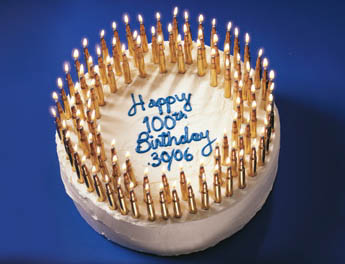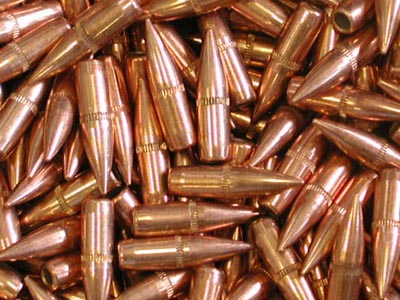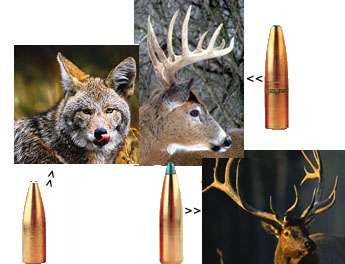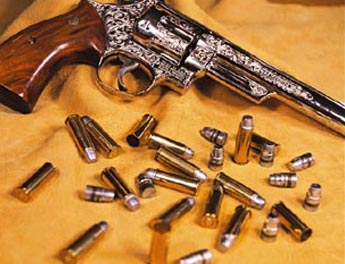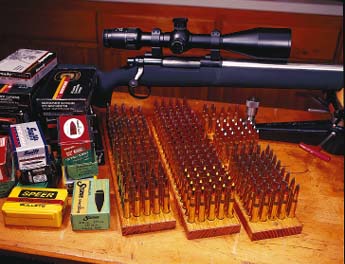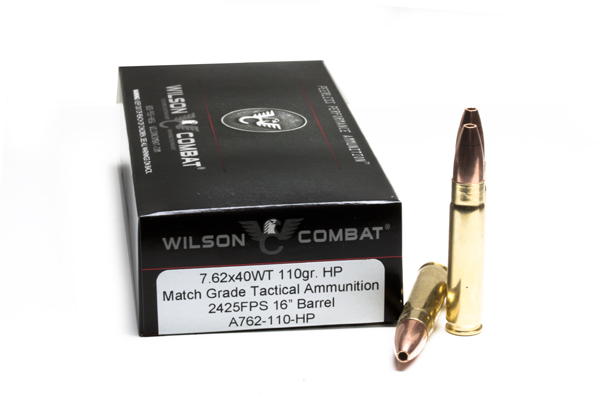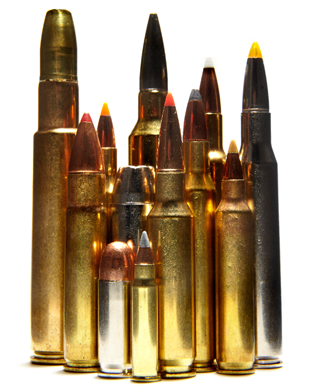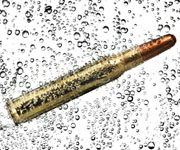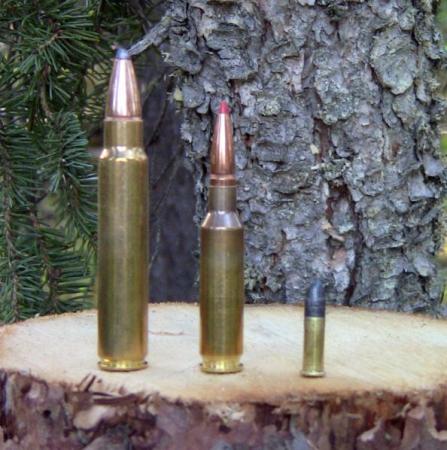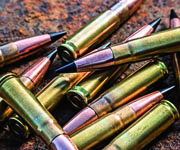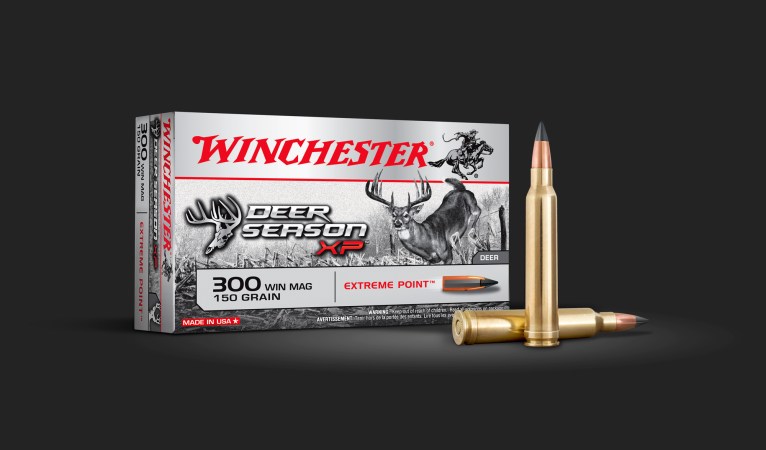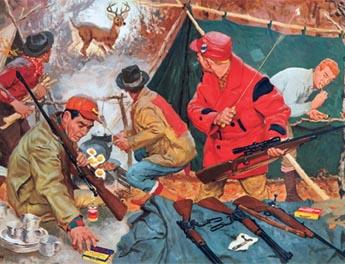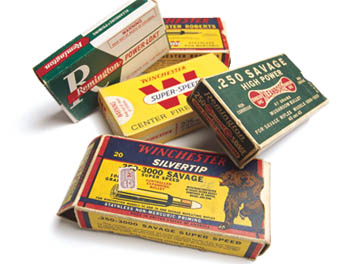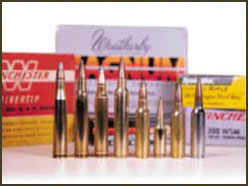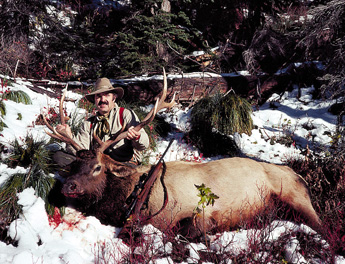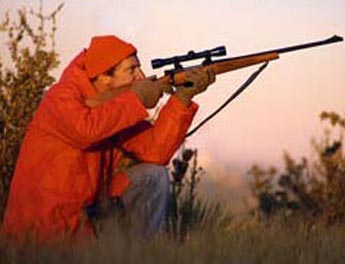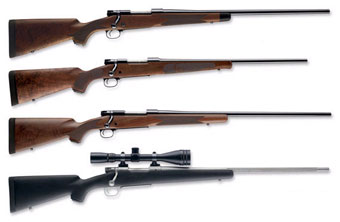We may earn revenue from the products available on this page and participate in affiliate programs. Learn More ›
The .30/06 is 100 years old. That’s right, the sweetheart of generations of American hunters has been around for a century, but don’t dare call her old.
Her exact birthday is October 15, the date the “Model of 1906” became the official designation of the U.S. .30-caliber service cartridge and Frankfort Arsenal geared up for production. That was also the year that the Chicago White Sox won their first World Series. A Ford auto cost $500, and another horseless carriage, the Locomobile, reached the breath- taking velocity of 110 miles per hour. President Roosevelt proclaimed Devil’s Tower our first National Monument, San Francisco was shattered by the most devastating earthquake in U.S. history and Outdoor Life was in its eighth year of publication. In December of 1906 the Ordnance Office ordered 15 million rounds of the new cartridge, the first of untold millions made since.
As a military cartridge, the ’06 was our longest-running caliber, serving for nearly a half century until it was replaced in 1954 by the 7.62×57 NATO (also known as the .308 Winchester), and was the predominant U.S. cartridge in both of the 20th century’s world wars and the Korean War. Its battle record is the most distinguished of any American service round, ranking it on a worldwide par with the .303 British and 8×57 German Mauser. Its enduring popularity, though, is due to its successes not on the battlefields but on the hunting fields.
An American Icon
In terms of popularity and widespread appreciation, no other caliber comes close. In a period when dozens of calibers have blossomed only to fade into obscurity within a few years, the .30/06 has not just survived but actually increased in popularity. If all other calibers were abolished tomorrow, there would be no great wringing of hands. The .30/06 is the American hunter’s sweetheart, apple pie and first kiss all in one. It does it all.
In terms of numbers, there isn’t even a second place to the .30/06. Name your category: ammo, rifles, reloading dies or bullets. The .30/06 is at the top of the list. Open the pages of any ammomaker’s catalog and there will be more load and bullet options for the .30/06 than for any other caliber. There have been times when the only caliber available in some makes and models of rifles has been the .30/06.
As an American standard, the .30/06 is the centerfire rifle caliber to which all other calibers are compared. There is probably no huntable game on Earth that has not fallen to the .30/06. When good folks like us gather around the campfire and start swapping tales about the .30/06, one question that never gets asked is how or why it got to be .30 caliber to begin with. Why not .29 or .32 or 8mm? Ask your hunting and shooting pals about this and you’ll likely get a short and very positive response: “Why that’s easy, it’s because thutty is the all-American caliber. Anybody who knows anything knows that for a fact.”
Well, no one would dare deny that .30 is indeed the all-American caliber, with bullets of that diameter being loaded in an array of case configurations, from relative pipsqueaks to blazing magnums. No question, the .30 was born, bred and nourished in America, and no fewer than five different .30-caliber cartridges have been adapted by the U.S. military. But for the real reason the .30/06 is a .30 we need to look further.
[pagebreak] Through the Years
If we search American cartridge catalogs back before 1890, we discover a dismal paucity of .30-caliber rounds: a couple of rimfire pistol calibers and a .30-30 Wesson (no kin to the .30-30 WCF), all long forgotten. Americans’ taste in calibers was either for smaller bores, such as the .25s, or for .32s and larger. However, when Springfield Armory began experimenting with a new cartridge in 1889 (a consequence of France’s 8mm Lebel, the first smokeless powder military cartridge), it hit on the .30-caliber.hen the chief of ordnance requested the commanding officer at Springfield to explain his choice, the C.O. reported it was completely arbitrary and, in his words, “not from any special principle involved,” just an “even” number to work with. Thus, simply for the convenience of tool makers at Springfield Armory, the .30 was destined to become the all-American caliber-which, when you think about it, makes more sense than whatever impulse may have been the justification for several other calibers.
The .30-caliber designation-30/100 of an inch-is an antiquated reference to the rifle’s bore size, the diameter of the hole bored in the barrel before rifling grooves are cut. With each rifling groove cut to a nominal 0.004-inch depth (depending on the maker) the groove diameter of a .30/06 rifle’s barrel becomes 0.308 inches. This, of course, is why .30/06 bullets are 0.308 inches in diameter, or pretty close to it. But there are no such limitations on the weights and shapes of bullets loaded in the .30/06, which over the past century have been manufactured in varieties that defy description. At one extreme is the sabot-encased, 55-grain Remington load with a muzzle velocity of 4,080 feet per second for plugging varmints. At the other are slugs of 220 grains or heavier that have been applied to everything from pachyderms to fish. (In a stretch of Virginia water where the “shooting” of fish is practiced, the locals maintain that 220-grain bullets from the .30/06 create the best concussive effect.)
The Three “Lost” Years
Though the .30/06 cartridge and the 1903 Springfield rifle are so intertwined in shooting lore that it is virtually impossible to speak of one without the other coming to mind, there is the curious matter of the missing three years between the adoption of the rifle and its soul mate. It’s a common question and requires a bit of explaining, going back to 1892 and the unrelenting stodginess of the U.S. War Department. Unlike their European counterparts, who went to war with each other on a regular basis and were thus inclined to equip their forces with the latest in rapid-fire weaponry, Americans were still of a mind-set left over from the Civil War. Repeating rifles led to wasted ammo, they reasoned, and the concept of small-caliber bullets driven to high velocities by the new smokeless powder was at odds with their certain knowledge that an enemy was killed deadest when drilled with heavy, large-caliber bullets like the 410-grain .45-caliber slugs from the .45/70 U.S. service rifle.
But since a smaller caliber seemed unavoidable in the army’s near future, it remained steadfastly determined at least to make the bullets as heavy as practicable. Thus, when the Krag-style rifle was adopted in 1892 (a first-class example of a mediocre design beautifully built), .30-40 Krag ammo was loaded with a rather cumbersome and ballistically inefficient roundnose 220-grain bullet.
This official policy favoring the heaviest possible .30-caliber bullets continued for the next decade, and when the new Mauser-style Springfield rifle was adopted in 1903, its companion cartridge-the .30/1903-was loaded with the heavy, roundnose .30-40-style bullet. About the same time, the U.S. War Department was beginning to pay attention to what was going on in the rest of the world, and something it noticed in particular was the pointy “S” (Spitzer) bullets of Germany’s 8mm Mauser round. The ballistically superior pointed bullets, though comparatively lightweight, yielded flatter trajectories and greater downrange energy than heavier roundnose bullets, not to mention being lighter to carry and cheaper to make. Accordingly, our guys at Frankfort Arsenal went back to their drawing boards and came up with a pointed bullet weighing only 150 grains and having a muzzle velocity of 2,700 fps (compared to about 2,300 fps for the 220-grain bullet). Since the lighter bullet had a shorter bearing surface, the neck length of the .30/03 case was shortened by a tenth of an inch. This “new” cartridge was ordered by the Ordnance Department late in 1906, and that’s how the .30/03 became the .30/06 and explains those missing three years.
[pagebreak] Though the .30/03 round is long obsolete and all but forgotten, it had its moments of glory, particularly in the specially built ’03 Springfield (Serial No. 6000) and Winchester M95 Lever rifle that Teddy Roosevelt took on his famous African safari.
On the Target Range
An oft-repeated sentiment regarding World War I infantry weapons is that the British went to war with a good battle rifle, the Lee Enfield; Germany with a good hunting rifle, the M98 Mauser; and America with a good target rifle, the 1903 Springfield. There is more than a modicum of truth in this sentiment. The U.S. military has a tradition of fine marksmanship and has long encouraged shooting excellence, especially with target competitions. These competitions range from semiformal post matches all the way up to highly trained teams and individuals intensely competing at national championships. No wonder the designers and developers of the 1903 Springfield had an eye on its accuracy and how well it would perform on the target range: They were target shooters themselves, with roots reaching back to “Berdan’s Sharpshooters” of Civil War legend.
By 1910 specially fitted and highly tuned National Match rifles were being built, virtually by hand, at Springfield Armory. Naturally, the accuracy of these rifles was complemented by specially loaded target-grade ammo, with commercial manufacturers-Remington and Winchester-vying with Frankfort Arsenal to produce the most accurate .30/06 ammo.
It is not mere hype to say that for many years the .30/06 ruled the target ranges. The fact of the matter is that shooters had no other choice. The rules governing the standard High Power Rifle National Match Course specified using the service cartridge, which, until the army switched to the 7.62 NATO in the 1950s, assured that shooters would use the .30/06. Nowadays, despite a preference for smaller calibers such as the .260 Remington for long-range target shooting, the .30/06 is still seen on the range and is even mandated for certain tournaments requiring M1 Garand or ’03 Springfield rifles.
Downtime for the ’06
Considering its unequaled approval rating, it’s hard to imagine a time when the .30/06 was out of favor, but there have been at least a few moments when it slipped in popularity polls (see “The Man Who Saved the .30/06,” above). In his 1940 book The Hunting Rifle, Col. Townsend Whelen states that from 1920 to 1930 the .30/06 enjoyed great popularity as a hunting cartridge, largely because “many articles extolling its virtues appeared on the sporting press, and naturally cartridge makers urface, the neck length of the .30/03 case was shortened by a tenth of an inch. This “new” cartridge was ordered by the Ordnance Department late in 1906, and that’s how the .30/03 became the .30/06 and explains those missing three years.
[pagebreak] Though the .30/03 round is long obsolete and all but forgotten, it had its moments of glory, particularly in the specially built ’03 Springfield (Serial No. 6000) and Winchester M95 Lever rifle that Teddy Roosevelt took on his famous African safari.
On the Target Range
An oft-repeated sentiment regarding World War I infantry weapons is that the British went to war with a good battle rifle, the Lee Enfield; Germany with a good hunting rifle, the M98 Mauser; and America with a good target rifle, the 1903 Springfield. There is more than a modicum of truth in this sentiment. The U.S. military has a tradition of fine marksmanship and has long encouraged shooting excellence, especially with target competitions. These competitions range from semiformal post matches all the way up to highly trained teams and individuals intensely competing at national championships. No wonder the designers and developers of the 1903 Springfield had an eye on its accuracy and how well it would perform on the target range: They were target shooters themselves, with roots reaching back to “Berdan’s Sharpshooters” of Civil War legend.
By 1910 specially fitted and highly tuned National Match rifles were being built, virtually by hand, at Springfield Armory. Naturally, the accuracy of these rifles was complemented by specially loaded target-grade ammo, with commercial manufacturers-Remington and Winchester-vying with Frankfort Arsenal to produce the most accurate .30/06 ammo.
It is not mere hype to say that for many years the .30/06 ruled the target ranges. The fact of the matter is that shooters had no other choice. The rules governing the standard High Power Rifle National Match Course specified using the service cartridge, which, until the army switched to the 7.62 NATO in the 1950s, assured that shooters would use the .30/06. Nowadays, despite a preference for smaller calibers such as the .260 Remington for long-range target shooting, the .30/06 is still seen on the range and is even mandated for certain tournaments requiring M1 Garand or ’03 Springfield rifles.
Downtime for the ’06
Considering its unequaled approval rating, it’s hard to imagine a time when the .30/06 was out of favor, but there have been at least a few moments when it slipped in popularity polls (see “The Man Who Saved the .30/06,” above). In his 1940 book The Hunting Rifle, Col. Townsend Whelen states that from 1920 to 1930 the .30/06 enjoyed great popularity as a hunting cartridge, largely because “many articles extolling its virtues appeared on the sporting press, and naturally cartridge makers
